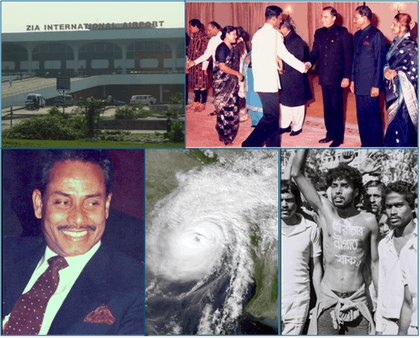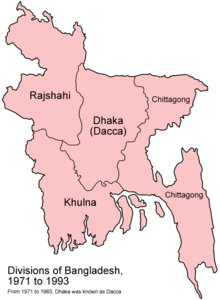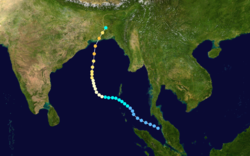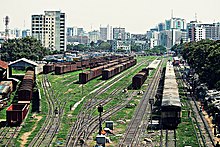1980s in Bangladesh
The 1980s (pronounced "nineteen-eighties", commonly shortened as the "'80s", pronounced "eighties") was a decade of the Gregorian calendar that began on January 1, 1980, and ended on December 31, 1989. For Bangladesh this decade was characterized by economic hardship, natural disasters and military dictatorship. Hussain Muhammad Ershad ruled Bangladesh almost throughout the decade. Infrastructure development was slow but there was notable progress in local government administration, population control and NGO led microfinance activities which boosted the rural economy. The urge of freedom of speech and return to democracy influenced the cultural activities in the decade.

Politics and National life
Assassination of Ziaur Rahman
The decade began with President Ziaur Rahman at the helm. Zia faced twenty one attempted coups against his government, including one by the air force.[1] His one time ally Colonel Abu Taher was tried for treason and executed. Similar fates were met by many of his perceived rivals in the armed forces. However, the final coup attempt resulted in his assassination in 1981. Zia was killed by troops loyal to Major General Abul Manzoor who stormed his official residence in Chittagong on 30 May 1981. The mutiny was later suppressed by army chief Lieutenant General Hussain Muhammad Ershad.[1]
Sattar administration
Zia was succeeded by Vice-President Abdus Sattar. President Sattar received a popular mandate during the 1981 presidential election, despite allegations of vote rigging by his rival Kamal Hossain. Sattar's presidency was marked by infighting within the ruling BNP, which forced cabinet reshuffles and the resignation of Vice-President Mirza Nurul Huda. A national security council was formed amid anti-Bengali Muslim violence in Northeast India and Burma.[2][2] Sattar also suffered from health problems due to old age.
The 1982 Bangladesh coup d'état deposed President Sattar and his civilian government.[2] The Bangladesh military cited food shortages, corruption and economic mismanagement as reasons behind the coup.
Ershad administration
Army Chief of Staff Lieutenant General Hussain Muhammad Ershad assumed power in a bloodless coup on 24 March 1982, citing the "grave political, economic, and societal crisis" that the nation was in. This move was not unanticipated, as Ershad had previously expressed distaste with the ageing Sattar (who was past his 75th birthday) and his handling of national affairs, in addition to his refusal to allow the army more participation in politics. Like his predecessors, Ershad suspended the constitution and—citing pervasive corruption, ineffectual government, and economic mismanagement—declared martial law. Among his first actions were to privatise the largely state-owned economy (up to 70% of industry was in public ownership) and encourage private investment in heavy industries along with light manufacturing, raw materials, and newspapers. Foreign companies were invited to invest in Bangladeshi industry as well, and stiff protectionist measures were put in place to safeguard manufacturing. All political parties and trade unions were banned for the time being, with the death penalty to be administered for corruption and political agitation. Ershad's takeover was generally viewed as a positive development, as Bangladesh was in a state of serious economic difficulty. Two weeks before the coup in March, Prime Minister Shah Azizur Rahman announced that the country was facing significant food shortages. The government also faced a severe budget deficit to the tune of 4 billion takas, and the IMF declared that it would not provide any more loans until Bangladesh paid down some of its existing debts. The following year, Ershad assumed the presidency, retaining his positions as army chief and CMLA. During most of 1984, Ershad sought the opposition parties' participation in local elections under martial law. The opposition's refusal to participate, however, forced Ershad to abandon these plans. Ershad sought public support for his regime in a national referendum on his leadership in March 1985. He won overwhelmingly, although turnout was small. Two months later, Ershad held elections for local council chairmen. Pro-government candidates won a majority of the posts, setting in motion the President's ambitious decentralisation program. Political life was further liberalised in early 1986, and additional political rights, including the right to hold large public rallies, were restored. At the same time, the Jatiya (National) Party, designed as Ershad's political vehicle for the transition from martial law, was established.[3]
Despite a boycott by the BNP, led by President Zia's widow, Begum Khaleda Zia, parliamentary elections were held on schedule in May 1986. The Jatiya Party won a modest majority of the 300 elected seats in the National Assembly. The participation of the Awami League—led by the late President Mujib's daughter, Sheikh Hasina Wajed—lent the elections some credibility, despite widespread charges of voting irregularities.[3]
Ershad resigned as Army Chief of Staff and retired from military service in preparation for the presidential elections, scheduled for October. Protesting that martial law was still in effect, both the BNP and the AL refused to put up opposing candidates. Ershad easily outdistanced the remaining candidates, taking 84% of the vote. Although Ershad's government claimed a turnout of more than 50%, opposition leaders, and much of the foreign press, estimated a far lower percentage and alleged voting irregularities.
Ershad continued his stated commitment to lift martial law. In November 1986, his government mustered the necessary two-thirds majority in the National Assembly to amend the constitution and confirm the previous actions of the martial law regime. The President then lifted martial law, and the opposition parties took their elected seats in the National Assembly.[3]
.jpg)
In July 1987, however, after the government hastily pushed through a controversial legislative bill to include military representation on local administrative councils, the opposition walked out of Parliament. Passage of the bill helped spark an opposition movement that quickly gathered momentum, uniting Bangladesh's opposition parties for the first time. The government began to arrest scores of opposition activists under the country's Special Powers Act of 1974. Despite these arrests, opposition parties continued to organise protest marches and nationwide strikes. After declaring a state of emergency, Ershad dissolved Parliament and scheduled fresh elections for March 1988.[3]
All major opposition parties refused government overtures to participate in these polls, maintaining that the government was incapable of holding free and fair elections. Despite the opposition boycott, the government proceeded. The ruling Jatiya Party won 251 of the 300 seats. The Parliament, while still regarded by the opposition as an illegitimate body, held its sessions as scheduled, and passed numerous bills, including, in June 1988, a controversial constitutional amendment making Islam Bangladesh's state religion and provision for setting up High Court benches in major cities outside of Dhaka. While Islam remains the state religion, the provision for decentralising the High Court division has been struck down by the Supreme Court.[3]
By 1989, the domestic political situation in the country seemed to have quieted. The local council elections were generally considered by international observers to have been less violent and more free and fair than previous elections. However, opposition to Ershad's rule began to regain momentum, escalating by the end of 1990 in frequent general strikes, increased campus protests, public rallies, and a general disintegration of law and order.[3]
Administrative Division

In 1980, Bangladesh was administratively divided into 4 divisions, namely Dhaka, Chittagong, Khulna and Rajshahi which were further subdivided into a total of 18 districts (See List of districts of Bangladesh). On 23 December 1982 the Local Government (Thana Parishad and Thana Administration Reorganisation) Ordinance was promulgated to introduce major changes with respect to the system of local government at the thana level. Under the reorganised set-up, thana was designated as the focal point of administration. In 1983, the Local Government Ordinance of 1982 was amended to re-designate and upgrade the existing thanas as upazilas (sub-districts).[4] Furthermore, during 1983-84, 46 new districts were created by upgrading them from thanas or upazilas. By the end of the decade the number of districts stood at 64.
Demographics
Based on World Development Indicators published by the World Bank[5] the population of Bangladesh grew from 79 million at the beginning of the decade to 104 million by the end. This signifies an annual population growth rate of 2.7%. Population density increased from 609 to 796 per sq. km.
The urban population was 14.9% of the total at the beginning, which ended up at 19.3%. Dhaka, the largest city, with a population of 3.3 million accounted for 27.0% of the total urban population by 1989. United Nations World Population Prospects[5] show that the population growth rate was in decreasing trend (from 2.8% per annum to 2.6%), primarily due to reduction in fertility rate (births per woman) from 6.4 to 4.7. Life expectance at birth increased from 53.5 years to 57.8 years with Child (0-5) mortality reducing from 199 per 1,000 births to 150. Age dependency ratio (% of working-age population) changed from 91.9% to 84.7% by the end of the decade.
Climate
Temperature and Precipitation
| Climate data for Bangladesh in 1980s | |||||||||||||
|---|---|---|---|---|---|---|---|---|---|---|---|---|---|
| Month | Jan | Feb | Mar | Apr | May | Jun | Jul | Aug | Sep | Oct | Nov | Dec | Year |
| Daily mean °C (°F) | 18.5 (65.3) |
20.8 (69.4) |
25.1 (77.2) |
27.6 (81.7) |
27.9 (82.2) |
28.4 (83.1) |
28.0 (82.4) |
28.3 (82.9) |
28.1 (82.6) |
27.0 (80.6) |
23.5 (74.3) |
19.8 (67.6) |
25.3 (77.5) |
| Average precipitation mm (inches) | 7.3 (0.29) |
20.0 (0.79) |
54.1 (2.13) |
182.0 (7.17) |
299.5 (11.79) |
434.4 (17.10) |
548.2 (21.58) |
419.6 (16.52) |
319.7 (12.59) |
157.8 (6.21) |
35.9 (1.41) |
14.2 (0.56) |
2,492.7 (98.14) |
| Source: Climatic Research Unit (CRU) of University of East Anglia (UEA)[6] | |||||||||||||
Compared to prior decade the average annual temperature increased by about 0.3 degree Celsius with most notable increases for the months of December and June. Average rainfall increased for April, May and July leading to overall average annual rainfall increase by about 131mm.[6]
Natural disasters

With severe flooding followed by tropical cyclone, 1988 was the year with the worst natural disasters in the decade, and probably one of the worst in the history of independent Bangladesh. The country experienced heavy rain and flooding in August–September 1988. Nearly 25 million people were rendered homeless and official death toll exceeded 500. About 30,000 km of roads were partially destroyed and rice crop on 3.5 million hectares was destroyed or damaged. The situation started to improve in late September, but people rendered homeless due to the flood continued to struggle. Striking in November 1988, a cyclone exacerbated the catastrophic damage from what was then considered the worst floods in Bangladesh's history. The brunt of the tropical cyclone's damage was inflicted upon coastal areas of Bangladesh and West Bengal. A total of 6,240 people were killed as a result of the storm, with 5,708 in Bangladesh. Many of the deaths were a result of the destruction of homes or electrocution after strong winds toppled power poles across the region. Along the coast of Bangladesh, strong storm surge caused heavy infrastructure damage and contributed in wiping out an estimated 70% of all harvestable Bangladeshi crops, with an estimated 200,000 tonnes (220,000 tons) of crops being lost.
Economy
National Income and Balance of Payment
Bangladesh GDP was USD 28.6 billion in 1980, which grew to USD 40.2 billion in 1989 (in 2010 constant dollar) signifying a 3.4% annual growth. Agricultural Sector contributed to 31.6% of GDP in the beginning of the decade, which increased to 32.9% by the end. During the same period contribution from the industrial sector decreased from 20.6% to 20.3% and that of the service sector decreased from 47.8% to 46.8%.[5] Per capita GDP marginally increased from USD 351 to USD 388 (in 2010 constant dollar).
According to World Development Indicators published by the World Bank,[5] on 2010 constant dollar basis, Bangladesh used to export USD 1.2 billion (5.5% of GDP) worth of goods and services as of 1980, which marginally declined to USD 1.1 billion (5.5% of GDP) in 1989. During the same time import of goods and services decreased from USD 4.6 billion (17.9% of GDP) to USD 2.8 billion (12.8% of GDP). Over the decade, Foreign Direct Investment and Personal Remittances Receipt averaged 0.01% and 2.64% of GDP; while, total Reserve averaged at 6.6% of external debt and 2.0 month's coverage of import.
Gross National Income (at 2010 constant dollar) grew from USD 22.3 billion to USD 28.4 billion over the decade. At the beginning of this period External Debt stock (of which concessional debt was 71.8%) was 6.1% of Gross National Income (GNI) and External Debt Service burden was 0.1% of GNI. By the end of the decade, External Debt stock (of which concessional debt now was 80.3%) stood at 19.1% of GNI and External Debt Service burden was 1.3% of the same. During the same period Military expenditure increased from 0.6% to 0.9% of GNI.[5]
Agriculture
Aggregate value addition from agricultural sector was USD 7.7 billion in 1980 (in 2010 constant USD), which grew at average annual rate of 1.4% to USD 8.9 billion by 1989 (in the same constant USD).[5] During this decade, crop production grew at an annual average rate of 2.0% driven by cereal production increase from 21.7 million metric tons to 27.9 million (implying annual growth of 2.5%) - enabled by improvement in cereal yield from 2006 kg per hectare to 2500 kg. At the same time livestock production grew at annual rate of 2.9% and fisheries production increased at 2.6% per annum. Altogether these contributed to overall food production increase by annualized rate of 2.2%.[5]
Industrial and Service Sectors
Net value addition from industrial sector, which stood at USD 4.0 billion in 1980 (in 2010 constant USD), grew at average annual rate of 5.2% to USD 6.6 billion by 1989 (in the same constant USD basis).[5] Manufacturing sector contributed 70.7% of industrial value added in the beginning of this period and it gradually changed to 64.6% by the end. By 1989 Manufacturers export accounted for 74.0% of total merchandise export while import supporting the manufacturing segment accounted for 56.7% of total merchandise import. In that year, textile and garments accounted for 37.7% of the value addition of the manufacturing sector. There were 1,347 recorded industrial design applications by Bangladeshi residents in this decade.[5] In 1979-80 there were 3,006 industrial establishments in the country employing 0.42 million staffs. By 1989-90 the number of establishments grew to 24,283 and employment in the sector grew to 1.08 million.[7]
On the other hand, net value addition from the service sector amounting USD 15.8 billion in 1980, also grew at average annual rate of 3.8% and stood at USD 22.9 billion by 1989 (in 2010 constant USD).[5] Major Businesses / enterprises that started journey in this decade in Bangladesh include Beximco Pharma in 1980, PRAN-RFL Group in 1981, BTI and Ha-meem Group in 1984, Orion Group, Paradise Group, S. Alam Group and Summit Group in 1985, Bashundhara Group in 1987 and Sheltech, Citycell and Meghna Group in 1989.
Infrastructure
Transportation and Communication

When Bangladesh achieved independence in 1971, it inherited 3,860 km of paved roads[8] which increased to about 6,600 km by end of 1980s.[9] On the contrary, by the end of the decade Bangladesh Railway was still operating a route of 2,800 km[9] - roughly the same as that in the earlier decade. A UNDP funded Bangladesh Transportation Sector Study executed by World Bank in 1988 estimated that by 1985 the ground transport system of Bangladesh was already supporting 35 billion km of passenger commute and 4.8 billion km of freight transport. Road network accounted for 64% of the passengers and 48% of the freight whereas 20% of the passengers and 17% of the freight were transported using the rail network - indicating a significant shift from rail to road network compared to earlier decade.[9] Still the railway sector was not uneventful in this decade. The Kamalapur railway station started providing container services with the establishment of the first inland container depot (ICD) of the country on 11 April 1987.[10] Furthermore, to improve operational efficiency and safety, an optical fibre digital telecommunication network was installed over 1,800 km connecting about 300 railway stations during 1985-90.[10]
The inland water transport sector also saw some development during this decade with the opening of major river ports at Nagarbari (1983), Aricha (1983), Daulatdia (1983), Baghabari (1983) and Narsingdi (1989).[11] However, ferry delays, siltation of the river system and shortage of capacity remained major bottlenecks of this sector.[9] Air Transport sector also did not grow much in this decade. As of 1979, there were 14,800 registered carrier departures worldwide which ended up to 14,600 by 1989. During the same period number of passenger carried increased from 0.62 million to about 1.00 million per annum.[5]
In the beginning of the decade there were 95,000 fixed telephone line subscription in the country - which increased to 192,000 by the end signifying 0.19 lines per 100 people.[5]
Energy
In 1980 per capital electric power consumption was 18.7 kWh, which increased to 49.2 kWh by 1989. During the same period per capital energy usage increased from 103.1 kg of oil equivalent to 116.8 kg and fossil fuel energy consumption increased from 32.1% to 45.1% of total.
In 1980 the electricity produced in the country was coming from: hydroelectric sources: 24.8%, natural gas sources: 48.6% and oil sources: 26.6%. By 1989 there was a significant move towards natural gas based electricity production and as a result, the distribution changed to hydroelectric sources: 12.9%, natural gas sources: 78.9% and oil sources: 8.2%.[5]
Financial Services
While in the 1970s the Financial Sector of Bangladesh was dominated by Public Sector banks (see here), in 1980s the Government started to pursue Privatization agenda. Uttara Bank and Pubali Bank were privatized in 1983. Other Private banks which started operation in this decade include Islami Bank Bangladesh, United Commercial Bank, The City Bank and National Bank in 1983, Arab Bangladesh Bank in 1985 and Al Baraka Bank (later named Oriental bank and subsequently ICB Islamic Bank) in 1987.
The government's encouragement during the late 1970s and early 1980s of agricultural development and private industry brought changes in lending strategies. The number of rural bank branches doubled between 1977 and 1985, to more than 3,330. Denationalisation and private industrial growth led the Bangladesh Bank and the World Bank to focus their lending on the emerging private manufacturing sector. Scheduled bank advances to private agriculture, as a percentage of sectoral GDP, rose from 2 percent in FY 1979 to 11 percent in FY 1987, while advances to private manufacturing rose from 13 percent to 53 percent.[12]
The transformation of finance priorities brought with it problems in administration. No sound project-appraisal system was in place to identify viable borrowers and projects. Lending institutions were often instructed by the political authorities. In addition, the incentive system for the banks stressed disbursements rather than recoveries, and the accounting and debt collection systems were inadequate to deal with the problems of loan recovery. The rate of recovery on agricultural loans was only 27 percent in FY 1986, and the rate on industrial loans was even worse. As a result of this poor showing, major donors applied pressure to induce the Government and banks to take firmer action to strengthen internal bank management and credit discipline. As a consequence, recovery rates began to improve in 1987. The National Commission on Money, Credit, and Banking recommended broad structural changes in Bangladesh's system of financial intermediation early in 1987, many of which were built into a three-year compensatory financing facility signed by Bangladesh with the IMF in February 1987.[12]
One major exception to the management problems of Bangladeshi banks was the Grameen Bank, which begun as a government project in 1976 and established in 1983 as an independent bank. In the late 1980s, the bank continued to provide financial resources to the poor on reasonable terms and to generate productive self-employment without external assistance. About 70 percent of the borrowers were women, who were otherwise not much represented in institutional finance. The average loan by the Grameen Bank in the mid-1980s was around Tk2,000 (US$25), and the maximum was just Tk18,000 (for construction of a tin-roof house). Repayment terms were 4 percent for rural housing and 8.5 percent for normal lending operations.[12]
The wave of Privatization touched the insurance sector and capital market as well. Until 1985, Jiban Bima Corporation was the only institution to handle life insurance business in Bangladesh. Through the Insurance (Amendment) Ordinance 1984 and Insurance Corporations (Amendment) Ordinance 1984, the government allowed the private sector to establish insurance companies.[13] In the mid-1980s, two private investment companies namely, National Credit Ltd. and Bangladesh Commerce and Investment Ltd., were permitted to participate in the capital market, although their activities remained limited.[14]
See also
Years in Bangladesh in the decade of
References
- Mascarenhas, Anthony. Bangladesh: A Legacy of Blood. Hodder and Stoughton.
- Preston, Ian, ed. (2003). A Political Chronology of Central, South and East Asia. Europa Publications. p. 18. ISBN 978-1-135-35680-4.
- Bureau of South and Central Asian Affairs (March 2008). "Background Note: Bangladesh". U.S. Department of State. Retrieved 11 June 2008. This article incorporates text from this source, which is in the public domain.
- Siddiqui, K. (2012). "Local Government". Banglapedia. Retrieved 17 Feb 2020.
- "World Development Indicators". The World Bank. Retrieved 27 May 2019.
- "Climate Change Knowledge Portal". The World Bank Group. Retrieved 23 December 2019.
- Report on Survey of Manufacturing Industries 2005-06. Bangladesh Bureau of Statistics.
- Islam, N. (23 February 2017). "DOMESTIC CONNECTIVITY IN BANGLADESH - A story of significant progress". The Daily Star. Retrieved 6 February 2020.
- World Bank. 1991. Bangladesh - Transport sector review (English). Washington, DC: World Bank.
- "Railway". Banglapedia. Retrieved 6 February 2020.
- "Water Transport". Banglapedia. Retrieved 6 February 2020.
- Heitzman, James; Worden, Robert, eds. (1989). "The Banking System". Bangladesh: A Country Study. Washington, D.C.: Federal Research Division, Library of Congress. pp. 109–112.
- Rahman, S M Mahfuzur (2012). "Jiban Bima Corporation". In Islam, Sirajul; Jamal, Ahmed A. (eds.). Banglapedia: National Encyclopedia of Bangladesh (Second ed.). Asiatic Society of Bangladesh.
- "Capital Market". Banglapedia. Retrieved 6 July 2020.